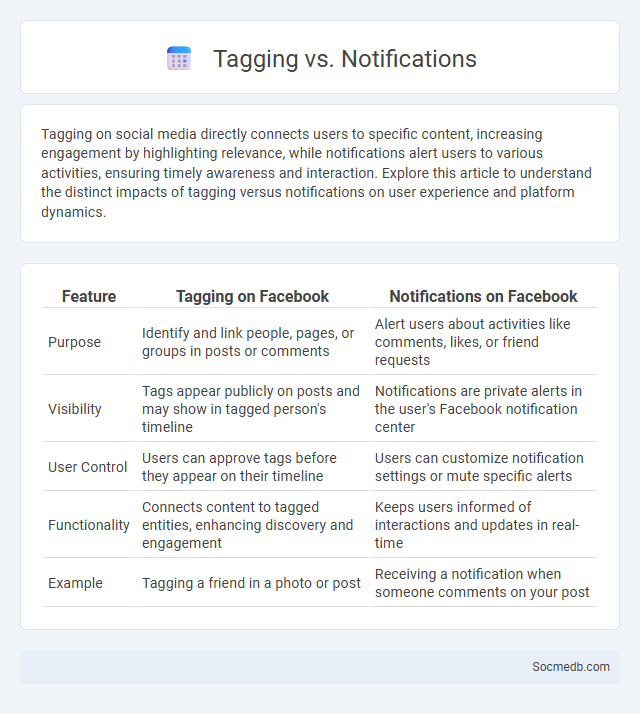
Photo illustration: Tagging vs Notifications
Tagging on social media directly connects users to specific content, increasing engagement by highlighting relevance, while notifications alert users to various activities, ensuring timely awareness and interaction. Explore this article to understand the distinct impacts of tagging versus notifications on user experience and platform dynamics.
Table of Comparison
| Feature | Tagging on Facebook | Notifications on Facebook |
|---|---|---|
| Purpose | Identify and link people, pages, or groups in posts or comments | Alert users about activities like comments, likes, or friend requests |
| Visibility | Tags appear publicly on posts and may show in tagged person's timeline | Notifications are private alerts in the user's Facebook notification center |
| User Control | Users can approve tags before they appear on their timeline | Users can customize notification settings or mute specific alerts |
| Functionality | Connects content to tagged entities, enhancing discovery and engagement | Keeps users informed of interactions and updates in real-time |
| Example | Tagging a friend in a photo or post | Receiving a notification when someone comments on your post |
Introduction to Tagging and Notifications
Tagging on social media enables users to directly link friends, brands, or topics within posts, enhancing content visibility and engagement. Notifications alert users about interactions such as comments, likes, or mentions, fostering real-time communication and user retention. Effective use of tagging and notifications boosts social networking by driving personalized user experiences and increasing platform activity.
Defining Tagging in Digital Platforms
Tagging in digital platforms involves labeling content or users with specific keywords or identifiers that link related information, enhancing discoverability and organization. This practice enables users to categorize posts, images, and videos, facilitating efficient search and personalized content curation across social media networks like Facebook, Instagram, and Twitter. Tags improve engagement by connecting users to relevant discussions, trending topics, and communities, optimizing the overall digital experience.
Understanding Notifications: Purpose and Functions
Notifications on social media platforms serve the critical purpose of keeping users informed about real-time interactions such as likes, comments, shares, and direct messages. These alerts enhance user engagement by prompting timely responses and driving continuous activity within networks like Facebook, Instagram, and Twitter. Optimized notification settings also allow customization, ensuring relevant updates without overwhelming users with excessive alerts.
Key Differences Between Tagging and Notifications
Tagging on social media involves mentioning a user directly within a post or comment, linking their profile to increase visibility and engagement. Notifications alert users about interactions such as likes, comments, or messages, ensuring they stay informed about their account activity. While tagging actively connects content to a specific user, notifications serve as passive updates that prompt user attention.
Types of Tagging in Modern Applications
Tagging in modern social media applications includes user tagging, hashtagging, and location tagging, each enhancing content discoverability and engagement. User tagging connects posts directly to individuals' profiles, enabling notifications and deeper interactions. Hashtagging categorizes content by themes or trends, while location tagging associates posts with geographic data for localized relevance.
How Notifications Enhance User Engagement
Notifications on social media platforms significantly boost user engagement by delivering timely, relevant updates that capture attention and prompt interaction. Personalized push notifications about likes, comments, or new content create a sense of urgency, encouraging users to revisit the app frequently. Data from platforms like Facebook and Instagram show a marked increase in daily active users and session length following optimized notification strategies.
Use Cases: When to Use Tagging vs Notifications
Tagging is ideal for directly involving specific users in social media posts, increasing targeted visibility and engagement by linking content to relevant profiles. Notifications serve best for alerting followers or selected individuals about updates, comments, or new posts without necessarily connecting them to the content itself. Choosing between tagging and notifications depends on whether the goal is to highlight participants explicitly or to broadcast information broadly within a social network.
Pros and Cons of Tagging vs Notifications
Tagging on social media enhances content discoverability and fosters engagement by directly linking users to posts or conversations, boosting visibility and interaction. Notifications alert You in real-time about activities, ensuring timely responses and increased user involvement, but excessive alerts can lead to notification fatigue and decreased user experience. Balancing tagging and notifications is crucial to optimize user engagement without overwhelming Your audience.
Best Practices for Integrating Tagging and Notifications
Effective social media management involves strategically integrating tagging and notifications to enhance user engagement and content discoverability. You should tag relevant accounts, locations, and keywords to increase reach, while setting up personalized notification preferences ensures timely interaction with your audience. Leveraging these best practices boosts visibility, strengthens community ties, and maximizes platform algorithms favoring active engagement.
Future Trends in Tagging and Notification Systems
Emerging trends in social media tagging emphasize AI-driven automation that enhances content discovery and personalized user engagement by analyzing contextual data and user behavior patterns. Notification systems are evolving towards hyper-personalization, using machine learning to deliver timely, relevant alerts that reduce notification fatigue and increase interaction rates. Integration of augmented reality (AR) and real-time sentiment analysis will further refine tagging accuracy and notification relevance, transforming how users interact with social platforms.
 socmedb.com
socmedb.com